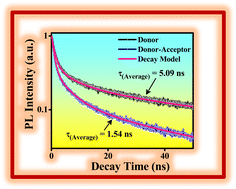Enhancing the FRET by tuning the bandgap of acceptor ternary ZnCdS quantum dots
Abstract
In this article, we report the band gap tuning of ternary ZnCdS quantum dots (QDs) by varying the concentration of the capping ligand, mercaptoacetic acid (MAA). The functionalization of QDs leads to the control of their size and band gap due to the quantum confinement effect, causing blue shift in the absorption and photoluminescence (PL) spectra with a gradual change in the concentration of the capping ligand from 0.5 to 2.5 M. Ensulizole (2-phenylbenzimidazole-5-sulfonic acid) is an important organic ultraviolet (UV) filter that is frequently used in sunscreen cosmetics. An effective overlapping of the PL spectrum of ensulizole and the absorption spectrum of QDs with 2.5 M MAA is achieved. A formidable decrease in the PL intensity and the PL lifetime of ensulizole promotes an efficient Förster resonance energy transfer (FRET) from sunscreen ensulizole to the QDs. The magnitude of the FRET efficiency (E) is ∼70%. This very high value of E is the signature of the existence of a very fast energy transfer process from ensulizole to the MAA functionalized ZnCdS QDs. The dyad system consisting of ZnCdS QDs and ensulizole sunscreen can serve as a prototype model to develop a better understanding of the photochemistry of ensulizole and consequently the formulation of more efficient sunscreen cosmetics.



 Please wait while we load your content...
Please wait while we load your content...